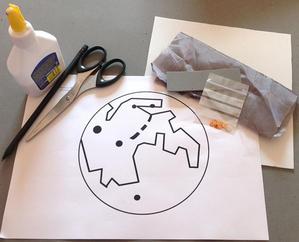Glossary term: 月球
Description: 月球是自身並不發光的天體,但它會反射落在其上的太陽光。這就產生了月球特有的月相。月球是地球唯一的主要天然衛星,其大小和質量在太陽系內的所有天然衛星中排名第五。在英文中,首字母大寫的“Moon”表示月球,而首字母小寫的“moon”則表示太陽系內外的其他天然衛星。與太陽系內的其他衛星相比,月球的體積相對於它所環繞行星的體積的占比是最大的。月球沿圍繞地球的橢圓軌道運行,與地球的平均距離為38.4萬千米。月球沒有大氣層,物質組分與地球類似,內核富含鐵,外層為岩石。這種相似並非偶然:據我們所知,大約45億年前,地球和一顆火星大小的行星碰撞,產生的碎片最終形成了月球,它的大部分物質來自最初的地球地幔。月球表面既有被稱為“月海”的深色區域,也有淺色高地,並布滿了隕擊坑。月球表面積為3.79×107平方千米,體積為2.20×1010立方千米,質量為7.35×1022千克。月球圍繞地球運行的軌道週期的確切數值取決於參考系:相對於遙遠的恆星,月球每27.3天運行一圈(“恆星月”)。對於地球上的觀測者來說,兩個新月之間的間隔時間為29.5天(“朔望月”)。
Related Terms:
See this term in other languages
Term and definition status: The original definition of this term in English have been approved by a research astronomer and a teacher The translation of this term and its definition is still awaiting approval
This is an automated transliteration of the simplified Chinese translation of this term
The OAE Multilingual Glossary is a project of the IAU Office of Astronomy for Education (OAE) in collaboration with the IAU Office of Astronomy Outreach (OAO). The terms and definitions were chosen, written and reviewed by a collective effort from the OAE, the OAE Centers and Nodes, the OAE National Astronomy Education Coordinators (NAECs) and other volunteers. You can find a full list of credits here. All glossary terms and their definitions are released under a Creative Commons CC BY-4.0 license and should be credited to "IAU OAE".
If you notice a factual or translation error in this glossary term or definition then please get in touch.
Related Media
阿波羅 11 號任務的月面活動
Credit: 美國國家航空航天局/阿波羅項目檔案 credit link
License: PD Public Domain icons
塞勒涅與月亮相遇,作者Sheila Wiwchar,加拿大
Credit: Sheila Wiwchar/IAU OAE
License: CC-BY-4.0 Creative Commons 姓名標示 4.0 國際 (CC BY 4.0) icons
紅月,法國丹尼爾·亨利昂作品
Credit: 丹尼爾·亨利/國際天文學聯合會教育辦公室
License: CC-BY-4.0 Creative Commons 姓名標示 4.0 國際 (CC BY 4.0) icons
正發生月食的月亮從多洛米蒂山脈(聯合國教科文組織世界遺產區)普倫德拉岩峰(Rochetta di Prendera )附近落下,作者 Alessandra Masi,意大利
Credit: Alessandra Masi/IAU OAE
License: CC-BY-4.0 Creative Commons 姓名標示 4.0 國際 (CC BY 4.0) icons
Related Activities
Lunar Landscape
astroEDU educational activity (links to astroEDU website) Description: Create craters and explore the lunar landscape with this hands-on activity.
License: CC-BY-4.0 Creative Commons 姓名標示 4.0 國際 (CC BY 4.0) icons
Tags:
Hands-on
, Model
, Lunar landscape
, Craters
Age Ranges:
4-6
, 6-8
, 8-10
Education Level:
Primary
Areas of Learning:
Modelling
Costs:
Medium Cost
Group Size:
Group
Skills:
Asking questions
, Communicating information
, Developing and using models
Meet Our Neighbours: Moon
astroEDU educational activity (links to astroEDU website) Description: Explore the tactile version of our moon with household materials.
License: CC-BY-4.0 Creative Commons 姓名標示 4.0 國際 (CC BY 4.0) icons
Tags:
Hands-on
, Model
, Visually Impaired
, Tactile
Age Ranges:
6-8
, 8-10
, 10-12
Education Level:
Middle School
, Primary
, Secondary
Areas of Learning:
Interactive Lecture
, Modelling
Costs:
Low Cost
Group Size:
Group
Skills:
Analysing and interpreting data
, Asking questions
, Communicating information
, Developing and using models
Lunar Day
astroEDU educational activity (links to astroEDU website) Description: Through a fun-learning activity, understand why moon always keeps the same face towards Earth.
License: CC-BY-4.0 Creative Commons 姓名標示 4.0 國際 (CC BY 4.0) icons
Tags:
Lunar day
Age Ranges:
4-6
, 6-8
Education Level:
Primary
, Secondary
Areas of Learning:
Modelling
, Structured-inquiry learning
Costs:
Free
Duration:
30 mins
Group Size:
Group
Skills:
Analysing and interpreting data
, Asking questions
, Communicating information
, Constructing explanations
, Developing and using models
Sun, Earth and Moon Model
astroEDU educational activity (links to astroEDU website) Description: Build an Earth-Moon-Sun mobile to learn about how they orbit.
License: CC-BY-4.0 Creative Commons 姓名標示 4.0 國際 (CC BY 4.0) icons
Tags:
Hands-on
, Model
Age Ranges:
8-10
Education Level:
Primary
Areas of Learning:
Game-mediated learning
, Modelling
, Social Research
Costs:
Medium Cost
Duration:
1 hour 30 mins
Group Size:
Group
Skills:
Asking questions
, Communicating information
, Developing and using models
Children's Planetary Maps: The Moon
astroEDU educational activity (links to astroEDU website) Description: An up close look at our own satellite
License: CC-BY-4.0 Creative Commons 姓名標示 4.0 國際 (CC BY 4.0) icons
Tags:
Maps
, Planetary cartography
, Spatial thinking
Age Ranges:
6-8
, 8-10
, 10-12
, 12-14
Education Level:
Middle School
, Primary
, Secondary
Areas of Learning:
Social Research
Costs:
Low Cost
Duration:
2 hours
Group Size:
Group
Skills:
Analysing and interpreting data
, Asking questions
, Communicating information
, Constructing explanations
, Developing and using models
, Engaging in argument from evidence
, Planning and carrying out investigations


















